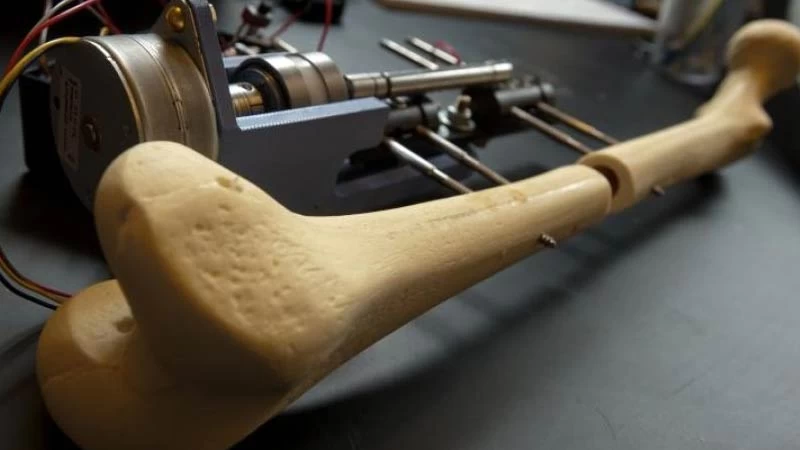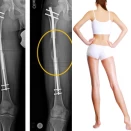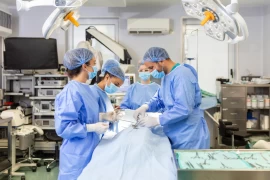
Lengthening Surgery
- Lengthening Surgery
- What are Length Extension Methods?
- Recovery processes after lengthening surgery
- How long does lengthening surgery take?
- Turkey Lengthening Surgery Prices
- Turkey Lengthening Surgery Success Rates
The surgical procedure, known as lengthening surgery, is a procedure that involves the use of external fixation devices to gradually lengthen the bones in the legs. Surgery is usually performed on people who have a condition that causes one leg to be shorter than the other or who want to increase height for aesthetic purposes.
The surgery is typically done in two stages. The first stage involves making an incision in the bone and attaching a device called an external fixator, which is a metal frame attached to the bone with pins. The fixator is then connected to a motor or manual device that enables the gradual separation of the bone. The patient typically needs to wear the fixator for several months; During this time, the bone begins to grow and heal.
The second stage of surgery involves removing the external fixator and allowing the bone to continue to heal for several more months. Physical therapy is typically required at this stage to help the patient regain strength and mobility in the leg.
Lengthening surgery is an important procedure that carries significant risks such as infection, nerve damage, and blood clotting. In addition, surgery is often very expensive and not covered by insurance. It should be noted that the procedure may not provide the desired height increase and in some cases may result in a slight decrease in height.
Overall, lengthening surgery is a complex and risky procedure that should only be considered after careful research and consultation with a qualified surgeon. It is important to carefully weigh the risks and benefits of surgery and to have realistic expectations about the results.
Limb lengthening: This surgery is used to increase the length of the bones in the legs or arms. It is often used to treat conditions such as dwarfism or leg length discrepancy.
Keep in mind that these procedures can have some complications and side effects, so it's important to have a clear understanding of the risks before undergoing any surgery.
What are Length Extension Methods?
COMBINED (LON) METHOD
Surgeries in the Combined Method:
If the Combined method is chosen to increase height, three operations are performed;
1- First Surgery; An intramedullary nail is inserted into the medullary (marrow) cavity of the bone, and then an external fixator is attached to the leg. Patients regularly turn the screws to lengthen the bone 1 mm per day. (Turn the screw with a metal key every 6 hours / 0.25 mm x 4)
2- Instrument Removal Surgery for External Fixator; When the desired length is reached, the nail is locked with screws to maintain the length achieved. The external fixator is then removed. The nail remaining in the bone canal will remain fixed until the new bone matures and hardens.
3- Intramedullary Nail Removal Surgery; After the bone healing is completed in approximately 12-15 months, intramedullary nails can be extracted according to the patient's request. This process takes about 30-45 minutes. He can return to his normal life after staying in the hospital for one night for control purposes. However, some patients continue to live with nails on demand.
Stryde Method
Stryde Nail is made by the same company that manufactures Precice Nail (NuVasive Specialized Orthopedics (NSO)) and has exactly the same design but different construction materials. In other words, it is a newer version of the previous “PRECICE 2” version of the intramedullary nail system.
There is a subtle difference between these last two advanced nails, the difference is in the material used. The Precice 2 is made of Titanium alloy, while the Stryde nail is made of steel making it 4 times stronger than the Precice 2 nail.
This is a very important detail because it means the doctor can encourage patients to gain more weight from the Precice 2 nail. In addition, there are no external metal apparatus attached to the feet.
Long and painful treatment times are the most obvious advantages over traditional external device lengthening methods by eliminating the risks that may lead to osteomyelitis such as needle tract infection.
Stryde nails are American-made intramedullary nails used for limb lengthening. An External Remote Control (ERC) is used to lengthen the nail by interacting with the magnets inside the nail. It is not currently implemented as it is still in the testing phase.

Precice 2
The Precice 2 system has been used since 2011 and has become one of the most preferred methods by most patients due to its convenience and low risk. In this surgery, an intramedullary nail is placed in the patient's bone. In addition, there are no external metal apparatus attached to the feet. Therefore, less pain, shorter treatment times and less risk of infection are remarkable advantages over methods with external devices.
PRECICE 2 nails are American-made intramedullary nails used for bone lengthening. It interacts with the magnets in the nail and the Remote Control (ERC) is used to lengthen the bone. The Remote Control is a portable magnetic device that provides extension by pressing the button on it. Thus, controlled elongation takes place.
The Remote Control is a portable magnetic device that provides extension by pressing the button on it. Thus, controlled elongation takes place.
Intramedullary Nail;
An intramedullary nail or rod is used as internal fixation and is made of titanium alloy. The doctor decides on the size of the nail by examining the x-ray images. (8.5 mm, 10.7 mm, 11.5 mm or 12.5 mm) It is surgically embedded in the bone cavity during surgery. Since the nail is bio-compatible, it does not contain any element that will harm the body.
Recovery processes after lengthening surgery
Recovery after leg extension surgery typically includes a long period of inactivity followed by physical therapy to regain strength and mobility. The length of recovery time depends on the extent of the surgery and the person's health, but can range from a few months to a year. Physical therapy may include exercises to regain range of motion, muscle strength, and stability. In addition, patients may need to use crutches or a wheelchair for a while.
It is important to follow the instructions given by the surgeon, including wound care, medications, and physical therapy instructions. It should be closely monitored by the surgeon to ensure proper healing and detect any complications.
Complications such as infection, nonunion, overstretching, nerve or blood vessel injury, and more can occur. It's important to have realistic expectations and be prepared for a long recovery period.
How long does lengthening surgery take?
The extended procedure takes about 1.5-2 hours. Patients can usually be discharged from the hospital 2 days later if no complications develop. The time between the completion of the healing process and the removal of the immobilization device varies according to the technique used and the age of the patient. For example, the time required for an adult to grow 5 cm with an intraosseous device is approximately 4-6 months.
Turkey Lengthening Surgery Prices
The price of lengthening surgery for the treatment of short stature caused by genetic, hormonal or environmental factors is as curious as the surgery. Since the lengthening surgery is done individually, the prices may vary from person to person. For this reason, fixed figures cannot be given for the prices of lengthening surgery. You can get detailed information about the procedure by contacting the specialist doctor to get the price of the lengthening surgery.
Turkey Lengthening Surgery Success Rates
The success rate of Turkey Length Extension surgery varies according to the technique used and the skill of the surgeon. Overall, the procedure has a high success rate and patients report satisfaction with the improved appearance of their height. However, as with any surgery, there is a risk of complications and the possibility of dissatisfaction with the final result. It is important to consult a qualified and experienced plastic surgeon to discuss the potential risks and benefits of the procedure and to have the surgery performed by an experienced, qualified professional.




